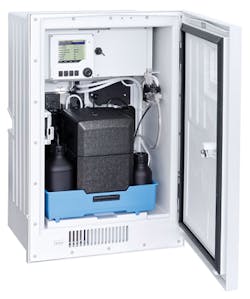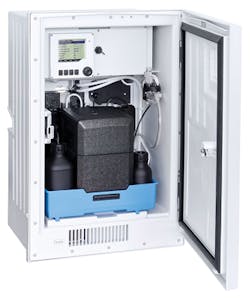Monitoring Nutrients with Photometric/Colorimetric Analyzers
By Steven Smith
Key considerations for getting the most out of your instrument
Permitted levels for ammonium and orthophosphate in effluent discharge are becoming increasingly tight as state environmental agencies and the U.S. Environmental Protection Agency (EPA) require dischargers to reduce the amount of nutrients in their wastewater.
Photometric/colorimetric analyzers can be used to monitor these chemicals. Operating this type of analyzer does not have to be an expensive proposition as long as the instruments are properly maintained. Here are some tips for the proper application and maintenance of a photometric/colorimetric analyzer to reduce total cost of ownership.
Sample Preparation Systems
A well-designed sample preparation system ensures a proper sample is provided to the analyzer and is the first step to a successful photometric/colorimetric analyzer installation.
Sample preparation systems are comprised of a filter immersed in the process, and a pump to extract a sample and deliver it to the analyzer. The filter should be positioned to ensure it is extracting a representative sample, and it should be easily accessible and easy to clean.
Some systems offer automatic cleaning with air or chemical backwash. Chemical cleaning can be critical in an influent installation where greases or oils can be present along with high biological activity, all of which can lead to filter or sample line plugging. For freezing weather environments, the sample system tubing should have a heating option.
Ammonium or orthophosphate can be measured using photometric/colorimetric analyzers. Shown is an Endress+Hauser CA80PH orthophosphate analyzer.
Analyzer Chemical Management
Analyzers consume reagent chemicals, and their operational costs rise and fall with reagent consumption. Each internal cleaning and calibration cycle also consumes chemicals.
The more reagent consumed with each analysis the higher the operating cost of the analyzer. The less reagent used, the longer a bottle of reagent will last. Some systems offer internal reagent cooling systems to help extend the life of reagents. Newer analyzer designs, with more precise reagent dosing systems, are capable of reducing chemical costs significantly. The analyzer should track reagent use and provide indication when it’s time to replace it.
The reagents required by the analyzer should be easy to prepare and have a long shelf life after preparation and installation. A longer shelf life allows bulk purchase of materials well in advance, which can reduce cost.
Component Wear and Service
Distributing samples and chemicals within a photometric/colorimetric analyzer requires tubing, pumps and valves. Users should examine the expected lifetime of each of these wear components as stated by the vendor.
Some analyzers need extensive part replacement using an array of tools. Newer analyzers are designed to significantly reduce the number of parts requiring service, virtually eliminate the need for tools, and dramatically reduce the time required to perform routine maintenance.
Control System Integration
Today, a range of output options exist to bring data from photometric/colorimetric analyzers to a control system. In addition to the traditional analog (4-20 mA) outputs, systems are available with a range of fieldbus digital communications, such as Profibus, Modbus or EtherNet/IP.
Summary
Photometric/colorimetric analyzers provide valuable information for the efficient operation of a water resource recovery plant. With careful consideration of several key attributes, plant operators can reliably obtain years of high-quality data at a reasonable cost. WW
Endress+Hauser is exhibiting at WEFTEC.18, booth 2851. For more information, visit endress.com.
Circle No. 304 on Reader Service Card

